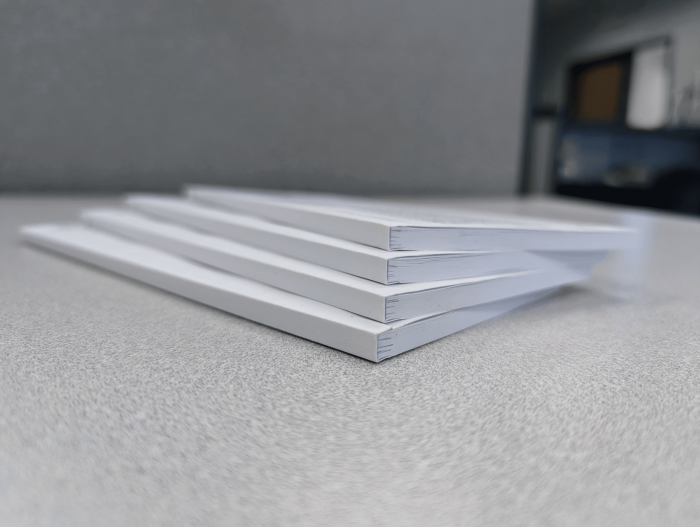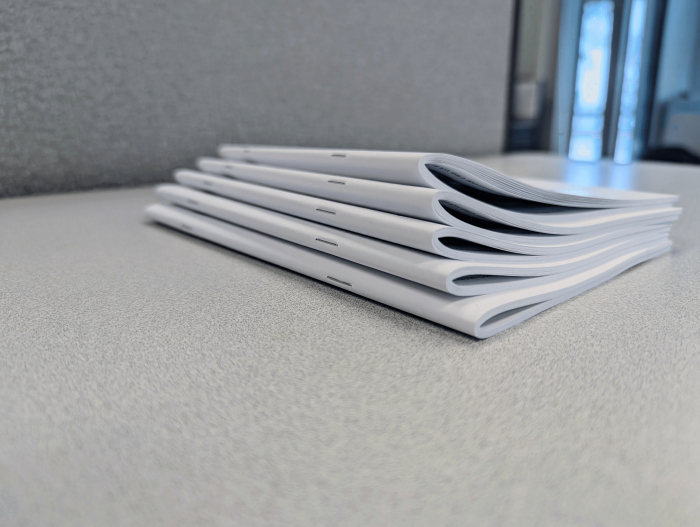When it comes to creating printed product manuals and instructions for use, choosing the right binding method is essential. Two popular options that are often compared are perfect bound and saddle stitch booklets. Both methods have their advantages and disadvantages, and understanding these can help you make an informed decision based on your specific needs. In this article, we will explore the benefits of perfect bound versus saddle stitch booklets, and the pros and cons of each, when it comes to producing your product manuals and IFUs.
Perfect Bound Booklets:
The Sleek and Professional Choice

Perfect binding is a method of bookbinding where the pages are glued to the spine of the cover, resulting in a sleek and professional-looking finished product. Here are some of the pros and cons of perfect bound booklets for printed product manuals and IFUs.
Perfect Bound Advantages
Durability: Perfect bound booklets are known for their durability. The pages are securely glued to the spine, which helps prevent them from coming loose or falling out, even with frequent use. This makes perfect bound booklets ideal for manuals and instructions that are meant to be referenced repeatedly over time.
Professional Appearance: Perfect bound booklets have a clean and polished appearance that gives a professional look to your product manuals. The cover can be printed in full color with high-quality graphics, and the spine can be customized with the title or logo, making it visually appealing and enhancing the overall branding of your product.
Flexibility in Page Count: Perfect bound booklets can accommodate a wide range of page counts, making them suitable for manuals and instructions of varying lengths, especially higher page counts. From thinner booklets with just a few dozen pages to thicker ones with hundreds of pages, perfect bound booklets can handle it all.
Perfect Bound Limitations
Cost: Perfect binding can be more expensive than other binding methods, such as saddle stitch. The process of gluing the pages to the spine requires additional materials and labor, which can add to the overall production cost, especially for small print runs.
Not Ideal for Small Manuals: Perfect binding may not be the best option for small manuals with only a few pages. Perfect Bound Booklets require a certain thickness in order for the binding to hold properly. If the book has too few pages, the spine may not be thick enough to hold the adhesive, which can cause the pages to fall out.
Difficult to lay flat: Perfect bound booklets can be difficult to lay flat, especially with thicker booklets, which can make them harder to use.
Saddle Stitch:
The Economical and Functional Choice

Saddle stitching, also known as stapling, is a binding method where folded pages are stapled together along the center fold and then trimmed to the finished size. Here are some of the benefits and limitations of saddle stitch for printed IFUs and manuals:
Saddle Stitch Advantages
Cost-effective: Saddle stitching is generally more cost-effective than perfect binding, as it requires fewer materials and labor. This makes it a budget-friendly option for manuals and IFUs, especially for large print runs or when cost is a primary consideration.
Quick Turnaround: Saddle stitching is a relatively quick binding method, as it does not require the additional time for gluing and drying. This can result in shorter production times, which may be beneficial when time is a critical factor.
Easy to handle: Saddle stitch booklets are lightweight and easy to handle, making them convenient for users to read.
Lay-flat Design: Saddle stitch booklets also lay flat when opened, making them easy to use and follow along with instructions. This feature ensures that users can have their hands free while working on a task without having to worry about keeping the manual open.
Saddle Stitch Limitations
Page Count Limitations: Saddle stitch is best suited for smaller page counts. If you have a manual that is too thick, saddle stitching may not be the best option, as the booklet may not lay flat or may become bulky and difficult to handle. Saddle Stitch machines also often have a page limitation built in, and many cannot exceed 80 pages. Additionally, due to the layout of saddle stitch booklets, page counts must be divisible by 4, and if the artwork is an odd number, additional blank pages must be added to accommodate.
Less Durable: Compared to perfect bound booklets, saddle stitch booklets may not be as durable. The staples used for binding can potentially come loose or cause pages to fall out with frequent use, especially if the booklet is handled roughly or subjected to heavy wear and tear.
Limited Cover Options: Saddle stitch booklets typically have a thinner cover compared to perfect bound booklets. This may limit your options for cover materials and finishes, which can impact the overall appearance and branding of your product.
Which is Better?
Both perfect bound booklets and saddle stitch have their advantages and disadvantages when it comes to IFUs and Manuals. Perfect bound booklets offer a sleek and professional appearance, durability, and flexibility in page count, but may be more expensive and generally don’t lay flat on their own. On the other hand, saddle stitch is more economical, and quick to produce, with a “lay-flat” design, but may have limitations in page count, durability, and cover options.
When choosing between perfect bound and saddle stitch booklets for your product manuals, consider factors such as your budget, the desired appearance and durability of the manual, the frequency of updates or revisions, and the overall functionality of the booklet. Assessing your specific needs and priorities will help you make an informed decision that aligns with your goals and budget. Ultimately, both binding methods can be suitable options depending on your unique requirements, and working with a professional printing company can provide valuable guidance and expertise in choosing the right binding method for your printed product manuals and IFUs.



